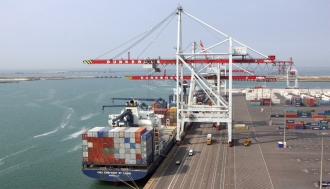Search Company:

A good transitional year
Not every port on the French coast can look back on 2014 with satisfaction. Dunkirk, however, has left no doubts about its performance after it reached a level of cargo throughput not seen since 2011, setting new records in the process. Early this year in Lille, CEO Stéphane Raison, chairman of the supervisory board François Soulet de Brugière and others provided an update on the hub’s plans to 2018.
Sometimes you have to set your sights on new horizons. The well known French research vessel Marion Dufresne II, which supplies the French southern and Antarctic regions in polar waters, among other things, did just that. The «floating laboratory», operated by CMA CGM, sailed into Dunkirk in mid-March for a general overhaul at the Dutch company Damen’s Dunkirk shipyard, where it is to be made seaworthy for the next 20 years of operations.
«A good transitional year»
Such a time frame is longer than a port can usually plan for, but Dunkirk recently set itself the goals it wants to achieve by 2018.
First, however, CEO Stéphane Raison, commercial director Daniel Deschodt and the chairman of the supervisory board, François Soulet de Brugière, presented the facility’s annual results for 2014 in the venerable lecture hall of the Ecole Supérieure du Journalisme in Lille.
The organisation managed to weather its year of three chief executive officers unscathed. The twelve months saw Christine Cabau Woehrel move to Marseille, Jean-Frédéric Laurent step in ad interim, and finally Stéphane Raison return to his home port from La Réunion.
Now all indicators – with a few exceptions – point to growth. Breakbulk and bulk cargo increased by a total of 8% to 47 million t, which represents a rise of 3.4 million t over the previous year.
Ro-ro traffic set a new record, making a 13% jump to 13.9 million t, and the number of trucks and trailers saw an increase of 14% to 570,000 loaded units. About 312,000 teu passed through the facility. These 2.9 million t are 7% more than were handled in 2013. An interesting detail is that the number of full containers rose by 6% to 177,000 teu. Breakbulk volumes saw double-digit growth of 12% to 17.8 million t, setting yet another record. In bulk cargo, ore (+13% to 13.5 million t) and cereals (+48% to 2.3 million t) made strong gains, and the latter reached a new all-time high. Raison characterised the throughput of coal as «a blot on our escutcheon». The decline came to 7% when compared with 2013. The facility suffered an equally hard blow in the liquid cargo field (–7%), which struggled both because Diester Industries shuttered its biofuels production facility, and also because traffic in mineral oil products declined. A total of 6,160 vessels called at Dunkirk in 2014, an increase of 7%.
Plans from 2015 to 2018
This year Dunkirk is poised to invest nearly EUR 40 million in its infrastructure, as a part of its five-year strategy.
As well as improving a terminal for traffic coming from the English Channel, the port will also ameliorate roads connecting it to the hinterland and expand a new customs post for the inspection of fresh goods. This will set the conditions for the growing import of fruit and vegetables from Morocco, for instance – a segment which rose by no less than 23% in 2014. At the same location, the lengthening of the Flanders quay to 600 m is one of the core projects in the offing. The extension of the berth is expected to be completed this year.
Dunkirk is developing an LPG partnership with Dover and Calais, an undertaking which has already piqued the interest of DFDS Seaways. The customer ArcelorMittal, in turn, commissioned a new crane in March, in order to direct minerals from its Canadian subsidiary Baffinland Iron Ore Mines to Dunkirk.
In sea traffic, Ocean3, the alliance between CMA CGM, China Shipping and UASC, began its FAL3 service in February, which improves Dunkirk’s connectivity as an import location for goods coming from China. The service cuts seven days off of previous transit times. «That is recognition for the work the port is carrying out,» says Soulet de Brugière.
Special location
CEO Raison has made no secret of the fact that, «Dunkirk is exposed to greater international competition from large European ports than any other facility in France.» An analysis of the hub’s trade flows has shown that the location has «everything to gain,» added commercial director Deschodt. In any case, the facility’s management wants to increase the previous 18% share of its business from transhipment over the coming years. For its next target, the maritime facility aims to break the 50 million t mark for cargo throughput.
Source: ITJ




